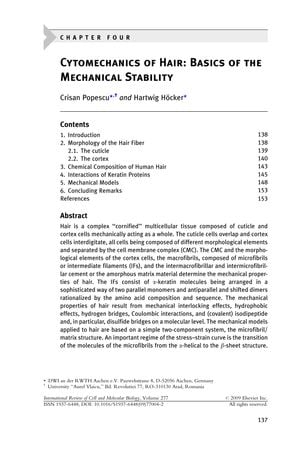TLDR Hair's strength and flexibility come from its protein structure and molecular interactions.
The document describes the cytomechanics of hair, explaining that hair is a complex tissue made up of cuticle and cortex cells that function mechanically as a unit. The mechanical properties of hair are determined by the cell membrane complex (CMC), macrofibrils composed of microfibrils or intermediate filaments (IFs), and the surrounding matrix material. The IFs are made up of α-keratin molecules arranged in a specific pattern influenced by their amino acid composition and sequence. Hair's mechanical properties are attributed to various molecular interactions, including mechanical interlocking, hydrophobic effects, hydrogen bonding, Coulombic interactions, and particularly strong disulfide bridges. Mechanical models for hair consider it as a two-component system of microfibril and matrix. A key aspect of hair's mechanical behavior is the transition of microfibril molecules from an α-helical to a β-sheet structure under stress. While hair exhibits negligible longitudinal swelling in water, it experiences significant radial swelling.
254 citations
,
January 2007 in “Chemical Society Reviews” Hair is a complex protein fiber with unique properties useful for developing hair products.
22 citations
,
January 2006 in “Journal of Structural Biology” Hair follicles form hard α-keratin filaments in four steps, showing structural differences.
91 citations
,
December 2000 in “The journal of cell biology/The Journal of cell biology” Scientists successfully created mouse hair proteins in the lab, which are stable and similar to natural hair.
76 citations
,
February 1993 in “Journal of Biological Chemistry” KAP6 genes are conserved across species and active in hair follicles.
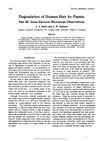 75 citations
,
November 1965 in “Textile research journal”
75 citations
,
November 1965 in “Textile research journal” Papain and bisulfite break down human hair by dissolving parts of it.
15 citations
,
August 2020 in “Analytical chemistry” Hair lipids do not protect against humidity.
 January 2019 in “Durham e-Theses (Durham University)”
January 2019 in “Durham e-Theses (Durham University)” Advanced microscopy shows hair damage and keratin proteins' roles, aiding future cosmetic treatments.
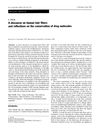 47 citations
,
June 1996 in “International Journal of Legal Medicine”
47 citations
,
June 1996 in “International Journal of Legal Medicine” Hair analysis for drugs needs a better understanding of how drugs enter hair, considering factors like hair structure and pigmentation.
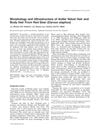 18 citations
,
November 2010 in “Journal of morphology”
18 citations
,
November 2010 in “Journal of morphology” Antler velvet hair and body hair of red deer have different structures that help with protection and insulation.
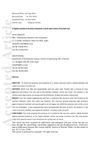 10 citations
,
November 2016 in “International Journal of Cosmetic Science”
10 citations
,
November 2016 in “International Journal of Cosmetic Science” A tough membrane between the outer and inner layers of human hair protects it from damage.
